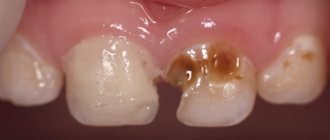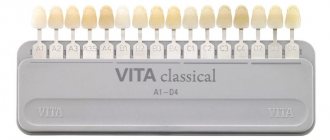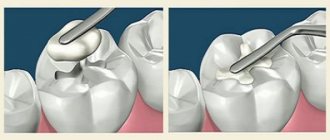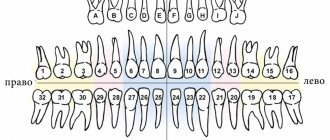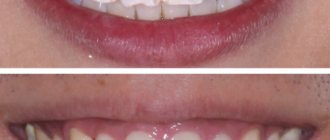Twinky Star, VOCO
Twinky Star is a light-curing compomer material for filling teeth. Available in a palette of 8 shades. Radiopaque. Manufacturer: VOCO.
Dental problems are one of the most common reasons why people go to the hospital. Some people think that children suffer from this less often, but this is actually not the case. Even baby teeth need protection and care. Their enamel is more vulnerable and susceptible to destruction more quickly, after which there is a risk of internal damage. There is a Twinkie Star product especially for such cases.
Description of the drug
Twinkie Star fillings are a dental compomer material. It has radiopaque properties and an increased light-curing effect. Other medical features of the drug include:
- The purpose of the drug is to quickly fill children's primary teeth.
- Has the effect of sparkles and light reflection.
- Polymerizes with blue and halogen-neon tints.
- Used simultaneously with dentin enamel bond.
- Manufactured using Twinky Star VOCO technology in Germany. The production is based exclusively on innovative, progressive methods and the achievements of dozens of scientists in the field of practical dentistry for children.
- The packaging of the material is selected in such a way as to facilitate the doctor’s work: it relieves the child of fear and psychological stress; ensures comfortable work with the drug, reduces the time spent on treatment.
- Has reduced abrasive effects.
- Its outer shell consists of natural fabrics that do not affect the composition in any way.
- Increased edge fitness.
- With proper use and care, Twinky Star fillings will last until a molar emerges.
- Contains an adhesive that significantly saves the doctor’s time during work and does not require conditioning.
Twinky Star colored fillings are the best solution for filling baby teeth
The idea that a baby tooth can be painted at the site of a carious hole in any color of the rainbow seems absurd only to adults, but children are simply delighted with it!
Adults strive to ensure that the filling is not visible at all. But children have a different way of looking at things! Therefore, unique Twinky Star colored fillings (Twinky Star, made in Germany) were created especially for children. Children's fears While a child is at a very tender age, he fantasizes, believes in fairy tales and miracles, and is often overshadowed by dental diseases. Between the ages of 6 and 12 years, 80% of children have teeth affected by caries. The reason for the bleak statistics lies not only in harmful bacteria and childhood laziness, but also in the unpronounceable term “dentophobia,” which popularly means “fear of the dentist and visiting the dental office.”
Parents, sometimes without realizing it, instill in their children a fear of dental treatment. Having their own negative experience from going to old, Soviet-style dental offices, in the corridors of which children’s crying and screams could be heard, adults do not develop correct hygiene skills in children, do not force them to brush their teeth and turn to the dentist in already very advanced cases accompanied by pain. But modern pediatric dentistry has long survived the Iron Curtain era and happily accepts useful innovations, one of which is Twinky Star colored fillings .
Treatment of baby teeth is a game. A pediatric dentist (who is also a psychologist) puts a lot of effort into his work. It is not easy for him to find an approach to the baby, to relieve him of fears and anxiety. But there is a reliable way to do this - to imagine the treatment process as a game. This is probably why children like colored fillings so much. Not only does the child take a direct part in the treatment of his teeth, he can then boast to his friends about his design habits. You can choose the color of the filling to match your dress, jacket, or just choose your favorite color.
Young patients really like the modern filling material Twinky Star with a shiny effect. Children take an active part in the treatment process - they independently choose the color of the future filling. There are enough color options for a child - there are 8 colors with sparkles in the palette: gold, silver, blue, pink, green, orange, lemon and blackberry. It was noticed that boys more often choose the blue shade of the future filling (67%), girls more often prefer pink, golden and orange shades (80%). Choosing a colored filling puts the child in a positive mood for treatment and children forget about fear in the dentist’s office. Twinky Star colored fillings for children are very durable and last until the baby teeth are replaced with permanent ones. They release fluoride ions, which help prevent caries.
Children treat colored fillings as decoration and monitor their safety more carefully and are more willing to brush their teeth. And the next time the child goes to the dentist’s office with joy, anticipating the choice of a new filling color.
This process captivates the child, captivates him, and he forgets about fears. And this is worth a lot. By the way, to the question of price. The prices for these and other services can be found on our website in the “ Our prices ” section.
Advantages of Twinky Star colored fillings. In addition to the fact that colored fillings motivate a child to visit the dentist, they are also a high-quality and reliable product.
Let's list the main advantages of children's colored fillings::
- Children really like it, eight bright and spectacular shiny shades, while children get rid of the fear of visiting the dentist
- They release fluoride ions into the tooth tissue, which strengthens and protects the tissue from secondary caries. When the fluoride runs out in the filling, she takes it out of the paste and the process repeats;
- Direct and fast filling from capsules. The filling hardens under the light of a special lamp;
- Twinky Star fillings combine the qualities of a composite and glass ionomer. This means that the filling adheres well to the walls of the tooth, is biocompatible with dental tissues, is durable, resistant to mechanical damage, and does not dissolve over time under the influence of saliva;
Packaging contents and release form
The packaging includes instructions for use and the drug itself. There are currently two forms of release of the substance.
Capsules
One set contains 40 pieces, packaged in special mini-containers. The peculiarity is the variety of shades of the material: green, orange, gold, silver, blue, pink, blackberry and lemon. The package contains 5 units of each color weighing 0.25 g.
Applicators
One set contains 100 pieces of cannulas, 2 g each.
Pros and cons of Twinkie Star
Dental material has many advantages, making it ideal for treating younger patients:
- Varied, vibrant color scheme.
- Convenient and easy to use both during the installation process and while the child is wearing the filling.
- The technology for creating Twinkie Star is completely original, so it has no analogues.
- After installing the filling, a substance – fluorine – is released from the Twinky Star material for a long period of time. It has a beneficial effect on the tooth and its root system.
- Biocompatibility during the filling procedure eliminates the need for additional sealing pads.
- Shrinkage takes a minimum amount of time due to hardening in two stages.
- The finished, solid filling retains its color and elasticity for a long time.
The only disadvantage of the drug is its low availability in dental clinics in Russia.
General presentation and purpose
Twinkie Star is a unique compomer radiopaque material characterized by a high degree of light curing. It has a glitter effect and is intended for filling baby teeth in children.
The product polymerizes with a blue halogen-neon color and is used in combination with enamel dentin bond.
Produced in Germany using VOCO technology, which is based only on innovative techniques and scientific developments in the field of pediatric practical dentistry.
Convenient packaging makes it easier to install the filling, reduces treatment time, and relieves psychological discomfort and fear.
Indications for use and contraindications
The main purpose of using the Twinkie Star set is filling baby teeth. In this case, indications for use may be different:
- Caries of cavities with stages up to the 4th class of damage. The only condition is the availability of complete isolation of the tooth from liquids.
- Tooth neck defect. Then the material is used as a preparation procedure.
- Well-defined enamel erosion. For example, when wedge-shaped anomalies appear.
- Mechanical injuries to fragments of hard tissue of a child’s jaw.
Like any other medication, there are several contraindications for which it is not recommended to use the substance for filling:
- Individual allergic reaction to the components of the drug.
- When a straight or non-straight surface of the dental pulp is detected.
- The working area in the oral cavity is a place with constant physical activity.
Directions and precautions:
- Twinkie Star contains Bis-GMA, diurethane dimethyl acrylate, TEGDMA, BHT.
- If it is impossible to reliably isolate the working area or use the filling technique described above, as well as if an allergy to individual components is identified, you should stop using the material.
- Twinkie Star is not recommended for direct or indirect dental pulp capping or occlusally loaded fillings in permanent teeth.
- Preparations containing eugenol or clove oil lead to disruption of the polymerization of composite filling materials. In this regard, exclude the use of cements containing zinc oxide or eugenol, as well as other eugenol-containing preparations in combination with composite filling materials.
- Twinkie Star is a compomer-based filling material with a special color effect. It is not the metals that give this sparkling color effect, but the addition of mica (an insoluble mineral). All colors meet food and cosmetic standards and are non-toxic. After polymerization, they are firmly locked into the composite. Their low content and insolubility are additional arguments against any doubts regarding the use of Twinkie Star.
Preparatory steps
Before proceeding with the installation of the Twinky Star color filling, it is necessary to carry out preparatory work. The purpose of preparation is to ensure complete sterility of the oral cavity and the diseased tooth, as well as to protect healthy tissue.
Sequence of preparation steps:
- Using a special paste that does not contain fluoride compounds, clean the surface of the dental tissues.
- Isolate diseased tissue from the rest of the mouth.
- Involve the little patient in choosing the color scheme of the material.
- Cavity preparation. It is important to strictly follow the technique. It is necessary to try to preserve as much healthy, adjacent tissue as possible.
- Use a stream of water to rinse the workplace, avoiding contact with blood or oral saliva.
- Remove excess moisture with warm spot air.
- Isolation of pulp tissue is usually not required. An exception is made if the location of the pulp is atypically close.
- Apply the adhesive sequentially, layer by layer every 40 seconds. In a standard situation, it is during this time that polymerization occurs.
- Process and polish.
When the preparation is completed, you can begin the final fluoridation at the ends of the filling or fill the entire tooth with the substance.
Instructions for use of the drug
Twinky Star fillings in baby teeth
Twinkie Star has simple instructions. The substance is placed in layers into the tooth cavity. The number of all layers depends on the required thickness of the filling. At this moment, do not forget about polymerization and the maximum thickness - no more than 2 mm.
During work, the following items are used: specialized caps, matrix devices of a translucent shade, wedges with increased light transmittance; for polymerization, a standard special device is used with a light ray power of at least 500 mW/cm2 for halogen and 300 mW/cm2 for LED. In order for the adaptation of the substance to dental hard tissues to take place efficiently, it is necessary to position the end of the Twinkie Star filling extremely close to the surface of the work area. If the dentist allows a gap of more than 5 mm, then the depth may be less and the polymerization process will change. Subsequently, this may happen:
- Defective (incomplete) adherence along the edges of the substance.
- Pigmentation or erosion of the filling.
- The occurrence of natural origin of bacterial pulpitis and its development.
You can proceed to processing and cleaning the finished surface only after completely removing the matrix using special disks. The final step of the work is coating the filled tooth with a fixing medical varnish.
Precautions and Tips
Despite the fact that Twinky Star material cannot cause serious harm, the doctor must still be careful when working with it. The main thing to remember is a few features:
- The substance does not tolerate contact with elements: eugenol, clove oil, which is found in many cement mortars. Their symbiosis will disrupt the polymerization of the material and reduce the quality of the result.
- Before starting work, make sure that the little patient does not have an individual intolerance to the components of the temporary filling.
- One of the properties of Twinkies is polymers that have a color reflection effect. However, this is not the result of light reflection from metals. This effect is obtained using the presence of mica. It has the property of not dissolving in a liquid medium and maintaining a low level of toxicity, which ensures an almost zero risk of allergic manifestations in younger patients.
Price
This filling procedure will not be cheap. One set of Twinkie Star filling material of 40 capsules costs approximately 7,600 rubles. For the entire process: first examination, diagnosis of treatment and placement of the filling itself - 2000 rubles. If you do not buy the entire kit, but only the materials spent on one tooth, and without the dentist’s work, you will approximately need to pay the patient’s parents the price of a Twinkie Star - from 700 to 1000 rubles.
Children, like many adults, do not like dental clinics. The sharp smell and sound of drilling frighten them greatly. Twinkie Star helped get rid of the main fears of young patients due to their participation in the process. In addition, from an early age, a child develops the habit of being attentive and caring about his health in general and the oral cavity in particular. The substance makes the dentist’s work easier: it hardens faster, does not require additional insulating gasket, excellent light reflection and other useful properties of the material.
How does the filling installation process work?
The whole point of filling, both when using regular and colored fillings, comes down to removing damaged tissues and replacing them with artificial ones. In any case, one goal is pursued - to preserve the functionality and aesthetics of a baby tooth for a longer period.
The filling process takes place in several stages:
- The area around the tooth is numbed. To do this, the doctor uses a suitable anesthetic with a precisely calculated dosage. If a child is afraid to give an injection right away, he is offered to anoint his gums with “fruit chill”.
- Then the dental cavity is thoroughly cleaned of damaged tissue. For these purposes, a drill, laser or sandblasting tools are used.
- During the treatment process, it is important to check the condition of the pulp. If it is not damaged, then disinfection is carried out. If the pulp is inflamed, a decision is made to remove it.
- After the doctor makes sure that the caries has been removed, the tooth cavity is cleaned of bacteria. At this stage, a special gasket is also installed that will protect the nerve from the applied filling material.
- Finally, the filling itself is carried out with the material of the selected color. It is applied in even layers. To make the filling hard, it is exposed to a special light. After this, polishing and grinding are carried out.
This is interesting: Dental flux on the gum and cheek: treatment at home, effective remedies for gumboil, symptoms
First meeting with the dentist
It is recommended to introduce the baby to the doctor as early as possible, explain that the doctor cares about his teeth and is ready to tell him how to care for them. If you bring a child to the dental office for the first time with already advanced caries and acute pain, then such an appointment will definitely not leave a pleasant impression. In the future, dental phobia (fear of treatment at the dentist) and a negative attitude even towards preventive measures may develop. Parents should understand that modern equipment and materials make treatment almost painless, and pleasant little things can distract and even please the child. This approach will be the key to a beautiful and healthy smile, as well as a positive attitude towards visiting the dental clinic.
What anesthesia is used?
Baby teeth, like molars, have nerves, so they can hurt. During treatment, different types of anesthesia are used (according to the depth of tissue damage). There are three types of anesthesia, including:
- applique. It is a spray or gel that reduces sensitivity only on the surface of the oral mucosa. Application anesthesia is harmless and completely safe for the child’s body. It is often resorted to before removing a moving molar. For the treatment of caries or pulpitis, topical anesthesia is not enough;
- infiltration The technique involves an injection that blocks the nerve endings of the desired area. The new generation of drugs act instantly; after 2-3 minutes the doctor begins to treat caries, pulpitis or remove a fixed molar. During manipulations, the child is not tormented by painful sensations;
- conductor. This is the most powerful type of pain relief. It affects the nerve branch of a large area. Conduction anesthesia is used in rare cases when infiltration anesthesia is not enough (for example, if it is necessary to treat several teeth at once).
In pediatric dentistry, products based on articaine hydrochloride are used as an anesthetic.
In pediatric dentistry, agents based on articaine hydrochloride are used for local anesthesia. The active substance has pronounced analgesic properties, but is non-toxic.
It rarely causes an allergic reaction and remains in the body for a short time. It is allowed to be used by children over 4 years of age.
What is the service life?
Most children's fillings are characterized by durability; they can last until the baby tooth falls out (taking into account proper and regular hygiene procedures). Standard service life is 2-3 years.
In many ways, the reliability of fixation and service life of the filling, as well as the prevention of secondary caries, depend on adhesive systems. For the treatment of primary molars and incisors, adhesive systems of 4-7 generations are most often used.
